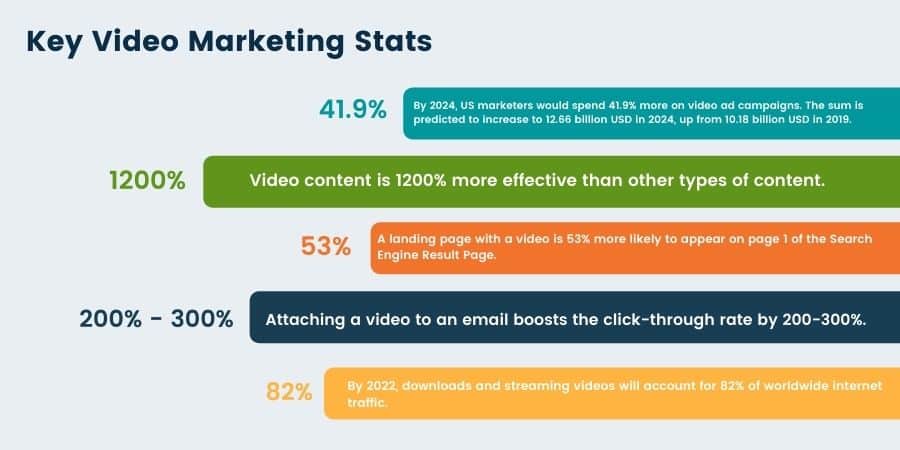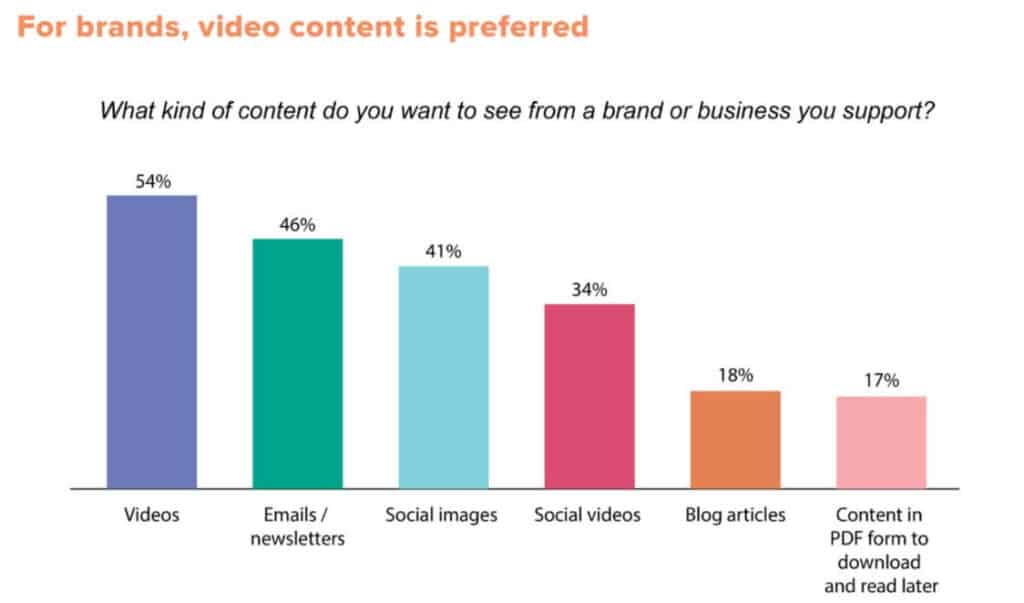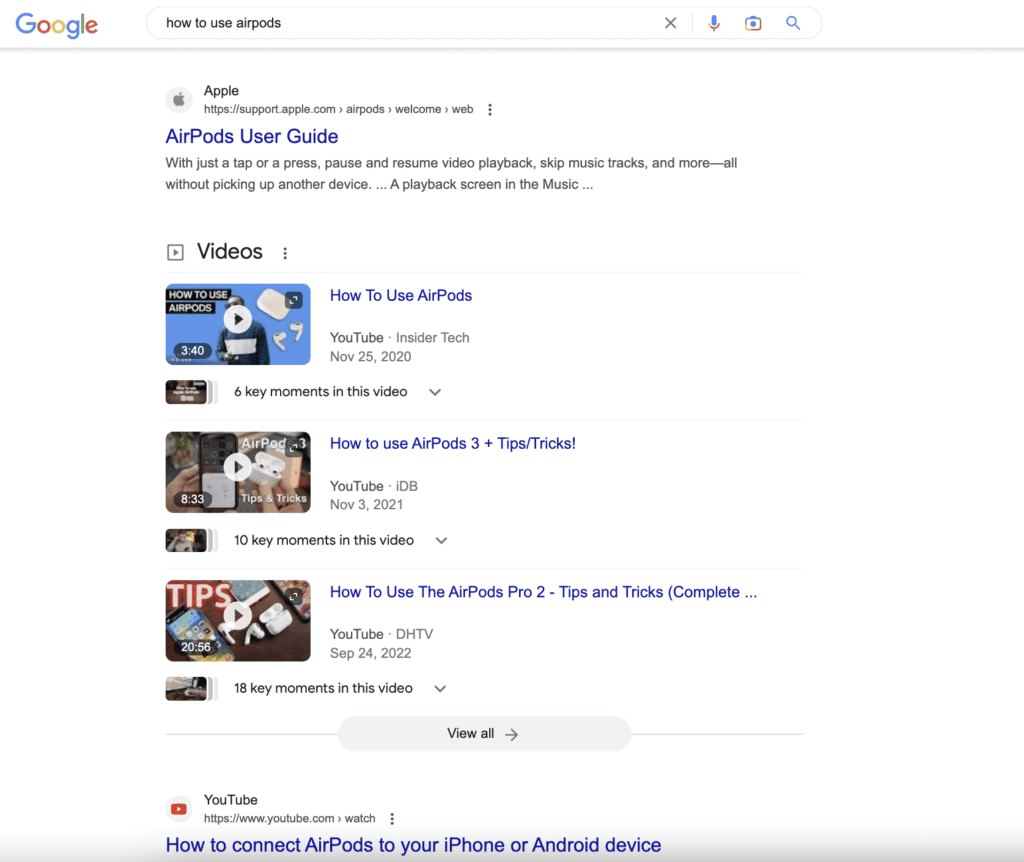
Video content is like the air we breathe – it’s everywhere, and there’s no escaping it. Love it or hate it, as marketers, we’re all aboard this fast-moving train.
Each video is more than just a play button. It’s a chance to captivate, connect, and convert, turning each second of screen time into a memorable experience.
It’s time to embrace the chaos and create video content that leaves a lasting impression. In this article, we’re sharing everything you need to know to not only meet, but surpass your video content goals.
Quick Takeaways
- In 2024, the significant increase in spending on video ad campaigns underscores the critical role of video in marketing strategies.
- Key Performance Indicators like view count, engagement rate, and conversion rate are essential for understanding and enhancing video content effectiveness.
- To make video content more effective, it’s crucial to know your audience, set clear objectives, focus on quality, optimize for SEO, encourage engagement, and analyze performance.
- Leveraging SEO through optimized titles, descriptions, transcripts, and social sharing is key to increasing the visibility and effectiveness of video content.
Understanding Video Content Goals
It’s 2024, and if you’re not thinking about video, you’re missing out. Big time.
Here’s a stat to chew on: US marketers are now spending 41.9% more on video ad campaigns than they did just five years ago, reaching a staggering $12.66 billion. That’s not pocket change!

Image Source: BuzzFlick
So, what are video content goals? Simply put, they’re your roadmap for what you want to achieve with your video content. Whether it’s boosting brand awareness, engaging your audience, or driving sales, each video you create should have a clear goal in mind.
Think of it this way: Every video is a chance to connect with your audience. Want to show off a new product? Make a video. Need to explain a complex idea? Video to the rescue. It’s about making sure your message hits home in the most effective way possible.
In short, setting clear video content goals is the difference between just adding to the noise and actually getting your message heard.
Key Performance Indicators for Video Content
Key Performance Indicators (KPIs) are the compass that guides your video strategy. Knowing your KPIs is your secret to knowing what’s working, what’s not, and where you need to steer your ship next.
- View Count: This one’s a no-brainer. How many people are watching your videos? More views can mean greater reach, but remember, it’s not just about quantity. It’s about who’s watching.
- Engagement Rate: Likes, shares, comments – these are the bread and butter of video engagement. High engagement rates often signal that your content is resonating with your audience. It’s like a virtual thumbs-up from your viewers.
- Click-Through Rate (CTR): If your video includes a call-to-action (CTA), this is your gold mine. A high CTR means people are taking action. Whether it’s visiting your website or buying a product, CTR moves your audience from viewers to doers.
- Conversion Rate: This is where the rubber meets the road. How many viewers are turning into customers or leads? A video that convinces viewers to take the plunge and buy your product or sign up for your newsletter is a video that’s doing its job.
- Watch Time: It’s not just about who clicks the play button; it’s about who sticks around. Longer watch times can indicate more engaging and compelling content. It’s a sign that viewers are not just interested, but invested.
- Social Sharing: When people share your video, they’re not just viewers; they’re advocates. Shares can exponentially increase your reach and are a strong indicator of content that strikes a chord.
Remember, these KPIs are insights into your audience’s hearts and minds. By keeping an eye on these metrics, you can fine-tune your content, strengthen your strategy, and make videos that don’t just look good, but also deliver real results.
Improving Video Content for Better Goal Fulfillment
Making your video content the best it can be is a must. Why? Because video content is king, and the throne is only getting bigger.
Here’s a stat that’ll make you sit up: Video content is 1200% more effective than other types of content. That’s right, 1200%! And, it’s the most preferred type of content among consumers. This shows just how crucial video is in today’s marketing landscape.

Image Source: Wave.video
So, how do you make your video content not just good, but great? Here are some key strategies:
- Know Your Audience: This is Marketing 101. Tailor your content to the interests, needs, and habits of your target audience. The more relevant your video is to your viewers, the more effective it will be.
- Set Clear Objectives: What do you want your video to achieve? Increase brand awareness? Drive sales? Your content should be designed with these goals in mind, from start to finish.
- Focus on Quality, Not Just Quantity: A well-made, engaging video is worth more than a dozen poorly made ones. Invest in good production values to make your content stand out.
- Optimize for SEO: Use keywords, compelling titles, and descriptions to make your video more discoverable. Remember, if they can’t find it, they can’t watch it.
- Encourage Engagement: Invite viewers to like, share, and comment on your videos. Engagement not only boosts your content’s visibility, but also provides valuable feedback.
- Analyze and Adapt: Use analytics to track the performance of your videos. Which ones are hitting the mark? Where can you improve? Use this data to refine your strategy.
Remember, in the world of video content, it’s not just about getting views. It’s about making an impact. By focusing on these key areas, you can ensure that your video content not only reaches your audience, but resonates with them, too.
Leveraging SEO for Video Content
For your video content to really work its magic, visibility is key. The good news is that getting your videos seen might be easier than you think.
Did you know that video results are 50 times more likely to be organically ranked in Google than text-based results? This shows the immense potential of video SEO.

Image Source: SE Ranking
So, how do you harness the power of SEO for your video content? Let’s break it down:
1. Optimize Video Titles and Descriptions
Your video’s title and description are like the welcome mat for your content. They need to be inviting, clear, and packed with the right keywords.
Start by researching keywords that are relevant to your video and your audience. Use these keywords naturally in your title and description.
Remember, your title should be catchy, but also informative. It should give viewers a clear idea of what to expect from your video.
2. Transcripts and Captions
Transcripts and captions aren’t just about accessibility; they’re also SEO gold. By providing a text version of your video content, you’re feeding search engines with rich, indexable content. This can help improve your video’s visibility in search results.
Plus, captions keep viewers engaged, especially those watching without sound. Tools like automatic captioning can help, but always review for accuracy.
3. Engaging Thumbnails
Think of your thumbnail as a visual handshake or a first impression. It should be compelling enough to entice viewers to click.
Use high-quality images that accurately represent your video content. Adding elements like short text descriptions or key visuals in your thumbnail can make it more appealing. A/B testing different thumbnails can also be a great way to see what works best for your audience.
4. Host Videos on Your Domain
Before you rush to upload your video on social platforms, consider hosting it on your own domain first. This strategy ensures that your website gets indexed as the primary source for the video, enhancing your site’s SEO.
Embed the video on your site in a way that complements your content. Also, make sure your hosting solution is fast and reliable to provide a good user experience.
5. Create Video Sitemaps
For videos hosted on your site, a video sitemap is a roadmap for search engines. It helps them find and understand your video content.
Your sitemap should include:
- Video titles
- Descriptions
- Play page URLs
- Thumbnail URLs
- Raw video file URLs
This can significantly improve the chances of your videos appearing in search engine results.
6. Leverage Social Sharing
The more your video is shared, the stronger the signal it sends to search engines about its relevance and quality.
Encourage viewers to share your videos on social media platforms. You can do this by adding social sharing buttons and making a direct call-to-action in your video. Remember, engagement on social media can also drive direct traffic to your video.
7. Quality and Engagement
At the end of the day, the quality of your content is paramount. High-quality, engaging videos are more likely to keep viewers interested and encourage shares and likes.
Focus on creating content that adds value to your audience. Monitor engagement metrics like comments and likes to gauge how your content is performing and use this feedback to refine your future videos.
Want to learn more about why SEO is key in meeting your video content goals? Watch this video from Lemonlight:
Video Source: Lemonlight
Common Pitfalls to Avoid in Video Content Creation
Creating video content can be a powerful way to engage your audience, but it’s easy to stumble along the way. Being aware of common pitfalls can save you time, resources, and ensure your video content hits the mark every time. Here are some key missteps to avoid:
1. Ignoring Your Target Audience
The biggest mistake you can make is not understanding who you’re creating content for. Always tailor your videos to the interests, needs, and preferences of your target audience. Failing to do so can result in content that resonates with no one.
2. Lacking a Clear Message or Goal
Every video should have a clear purpose. Whether it’s to inform, entertain, or sell, your message should be concise and focused. Videos that try to cover too much often end up confusing and losing the viewer’s interest.
3. Compromising on Quality
While you don’t need Hollywood-level production, poor video and audio quality can be a major turn-off. Invest in good equipment or professional help to ensure your videos look and sound their best.
4. Overlooking SEO Best Practices
As we’ve discussed, SEO is crucial for video visibility. Neglecting elements like titles, descriptions, and keywords can result in your content being hard to find, no matter how good it is.
5. Underestimating the Power of Storytelling
Videos that tell a compelling story are more likely to engage and be remembered by your audience. Avoid creating bland, salesy content. Instead, focus on storytelling to connect with your viewers on a deeper level.
6. Ignoring Analytics and Feedback
Not reviewing your video performance data is like flying blind. Use analytics to understand what works and what doesn’t. Also, pay attention to viewer feedback for insights into how your content is being received.
7. Inconsistent Posting
Consistency is key in building an audience. Sporadic posting can make your brand seem unreliable. Develop a content calendar and stick to a regular posting schedule.
8. Failing to Promote Your Videos
Creating great content is just half the battle. Failing to promote your videos on social media, email newsletters, and other channels can severely limit your reach.
9. Not Encouraging Viewer Engagement
Engagement (likes, comments, shares) boosts your video’s visibility and helps create a community around your brand. Always include a call-to-action encouraging viewers to engage with your content.
10. Overlooking Mobile Optimization
With the majority of video content being consumed on mobile devices, not optimizing your videos for mobile viewing can lead to a poor user experience.
Achieve Your Video Content Goals Today
Achieving your video content goals is about connecting and engaging. We’ve covered the essentials: setting clear objectives, mastering SEO, and steering clear of common pitfalls.
Remember, successful video content is a blend of strategic planning, audience understanding, and quality execution. Keep these points in mind, and you’re well on your way to creating videos that don’t just exist in the digital space, but make a real impact.
Ready to achieve your video content goals? Check out our SEO Blog Writing Service or schedule a quick consultation to learn more about how Marketing Insider Group can help you earn more leads for your business.
0 Commentaires